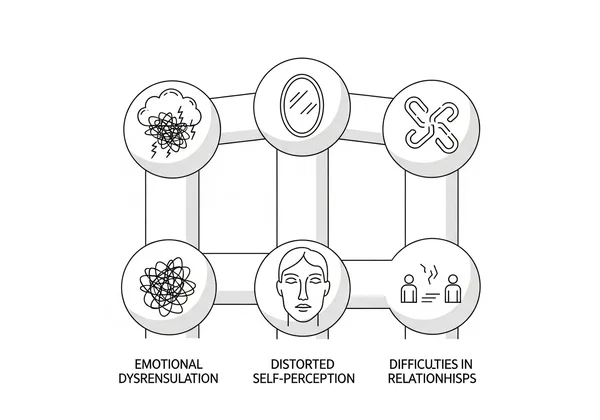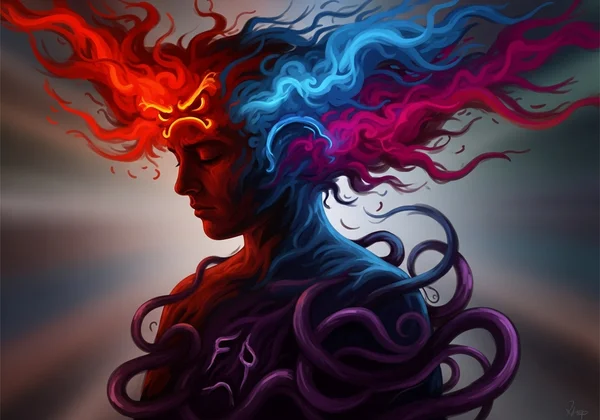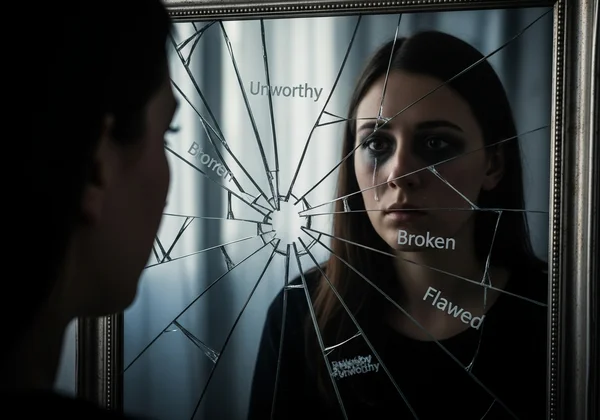Do I Have CPTSD? Core Symptoms & Complex Signs
Do you often feel overwhelmed, misunderstood, or a persistent sense that something is 'wrong' – something you can't quite name? If you've lived through prolonged or repeated trauma, you might be facing challenges that go beyond the typical understanding of PTSD. Many ask, 'How can I tell if I have CPTSD?' This guide aims to bring you clarity and validation by exploring the core CPTSD symptoms and complex signs of Complex Post-Traumatic Stress Disorder.
Many people find that putting a name to their experience is the first step toward healing. While this article provides information, a structured assessment can offer personalized insight. To see how your experiences might align, consider taking our free, confidential CPTSD test. It's a simple first step on your path to understanding.

Understanding the Foundation: What Are CPTSD Symptoms?
Complex PTSD arises from prolonged or repeated traumatic events, such as ongoing childhood abuse, domestic violence, or long-term emotional neglect. Unlike single-incident trauma, this sustained exposure deeply impacts a person's development, sense of self, and ability to connect with others. The symptoms, therefore, are layered and multifaceted.
To understand CPTSD, we first need to acknowledge its foundation in PTSD and then explore what makes it "complex." This framework, recognized by the World Health Organization's ICD-11, helps distinguish the condition and validate the unique struggles of survivors.
The Key Difference: CPTSD vs. "Regular" PTSD
Standard PTSD is primarily defined by three symptom clusters: re-experiencing the trauma (e.g., flashbacks, nightmares), avoidance of trauma-related reminders, and a persistent sense of current threat (e.g., hypervigilance). While individuals with CPTSD experience these, they also face an additional set of challenges that stem from the interpersonal and developmental nature of their trauma.
This distinction is crucial because it addresses the profound impact that long-term trauma has on one's identity and relationships, something not fully captured by a standard PTSD diagnosis.
Introducing Disturbances in Self-Organization (DSO)
The "complex" in CPTSD refers to three categories of symptoms known as Disturbances in Self-Organization (DSO). These are the pillars that separate CPTSD from PTSD. They are:
- Emotional Dysregulation: Severe and persistent difficulties managing emotions.
- Distorted Self-Perception: Deep-seated negative beliefs about oneself.
- Difficulties in Relationships: Ongoing problems forming and maintaining connections.
Understanding these DSO clusters is key to recognizing the full picture of CPTSD.

Emotional Dysregulation & Intense Feelings
One of the most defining features of CPTSD is a struggle with managing emotions. This isn't just about feeling sad or angry; it's about emotions feeling overwhelming, uncontrollable, and often disconnected from the present moment. Survivors might feel like they are constantly on an emotional roller coaster.
This emotional intensity can be confusing and exhausting. A CPTSD self-assessment can help you map these feelings to specific patterns, providing a clearer picture of what you're experiencing.
Navigating Overwhelming Emotional Flashbacks
Unlike the visual flashbacks of PTSD, emotional flashbacks in CPTSD are intense emotional states from the past that flood you in the present. You might suddenly feel the same terror, shame, or hopelessness you felt during the original trauma, without any visual memory attached. These can be triggered by seemingly minor events, leaving you feeling confused and dysregulated.
Sudden Mood Swings and Managing Anger/Sadness
A CPTSD outburst can feel like it comes out of nowhere, but it's often a delayed reaction to a trigger or built-up stress. You might experience sudden shifts from numbness to intense rage or deep, inconsolable sadness. This isn't a character flaw; it's a nervous system struggling to regulate itself after prolonged exposure to danger.

Distorted Self-Perception: The Inner World of Complex PTSD
Long-term trauma, especially during childhood, teaches you harmful lessons about yourself. It can leave you with a core belief that you are worthless, broken, or fundamentally flawed. These beliefs become the lens through which you see yourself and the world.
This distorted self-perception is not your fault. It is a direct result of the trauma you endured. Acknowledging these patterns is a brave step toward self-compassion and healing.
Profound Feelings of Shame, Guilt, or Worthlessness
Toxic shame is a hallmark of CPTSD. It's a pervasive feeling that you are bad, rather than that you did something bad. You might also carry immense guilt, often for things that were not your fault, such as not being able to stop the abuse or "provoking" an abuser. These feelings can lead to a sense of being different and isolated from others.
Persistent Self-Criticism and Self-Blame
Do you have a harsh "inner critic" that constantly berates you? This voice often mirrors the words or attitudes of a past abuser. It nitpicks your every move, blames you for any misfortune, and convinces you that you are never good enough. This relentless self-attack is a learned survival mechanism that has become deeply ingrained.

Challenges in Relationships & Social Connections
When your formative experiences with people were unsafe, learning to trust and connect becomes incredibly difficult. CPTSD significantly impacts your ability to feel safe with others, leading to patterns of isolation or tumultuous relationships.
If you recognize these patterns, know that you are not alone. Many who explore their symptoms find that relational difficulties are a major component of their struggles.
Difficulty Forming and Maintaining Secure Bonds
Trusting others can feel impossible. You may keep people at a distance to avoid being hurt, even if you desperately crave connection. Alternatively, you might attach too quickly, seeking the safety you never had, only to be disappointed or to push others away when intimacy feels threatening.
Patterns of Idealization and Devaluation in Relationships
It's common to vacillate between putting someone on a pedestal and then devaluing them when they inevitably reveal their human flaws. This push-and-pull dynamic stems from a deep-seated fear of abandonment and a longing for a perfect rescuer. It is a painful cycle that can leave you feeling chronically lonely.
Understanding Dissociation: Feeling Detached
Dissociation is a mental escape when a physical one isn't possible. It's the brain's way of protecting you from overwhelming pain or terror. For those with CPTSD, it can become a default coping mechanism that persists long after the trauma has ended, making you feel disconnected from yourself, your body, and the world.
Depersonalization and Derealization: Disconnected Experiences
Depersonalization is the feeling of watching yourself from the outside, as if you're in a movie. Derealization is the sense that the world around you isn't real or feels foggy and distorted. These states, which can be part of a "freeze in CPTSD" response, are disorienting and can make you question your own sanity.
Memory Gaps and Trauma-Related Amnesia
It is very common for survivors of prolonged trauma to have significant gaps in their memory, especially concerning the traumatic periods. You may struggle to recall large chunks of your childhood or specific events. This isn't a sign of a bad memory; it's a powerful protective function of dissociation.

Your Path to Self-Understanding & Moving Forward
Coming to terms with these complex CPTSD symptoms can be an overwhelming, yet deeply validating, experience. It marks a significant first step: understanding that your struggles aren't personal failings, but rather natural responses to unbearable situations. Your journey toward clarity has already begun.
While this guide provides a foundation, a structured assessment can offer even more personalized insights into your unique experiences, helping you translate confusing symptoms into a clearer picture and guiding your next steps.
Ready to see how your experiences align with CPTSD? You can take our free, confidential, and scientifically-backed CPTSD test online today to receive a personalized preliminary assessment. This tool, based on the International Trauma Questionnaire (ITQ), is designed to empower you with valuable knowledge.
Disclaimer: Please remember, this information is for educational purposes only and not a substitute for professional diagnosis. The test is a screening tool. If you suspect you have CPTSD, it is essential to consult a qualified mental health professional.
Frequently Asked Questions About CPTSD Symptoms
How can I tell if I have CPTSD without a formal diagnosis?
You might start by noticing if you consistently experience the symptom clusters we've discussed: re-experiencing, avoidance, and threat perception, along with the three areas of DSO (emotional, self-perception, and relational difficulties). A scientifically-based screening tool, like our free CPTSD quiz, can also offer a structured way to review your symptoms and see if they align with the CPTSD framework.
What everyday struggles do people with CPTSD face?
Daily life can be exhausting. Common struggles include chronic fatigue, difficulty concentrating, managing work responsibilities, dealing with sensory overload (like loud noises or bright lights), and navigating social situations that feel draining or threatening. Simple tasks can feel monumental when your nervous system is constantly on high alert.
Is CPTSD the same as Borderline Personality Disorder (BPD)?
This is a common point of confusion, and there is significant symptom overlap, like emotional dysregulation and relationship difficulties. However, the core of CPTSD is rooted in trauma and a negative self-concept (shame, guilt), while BPD is often characterized by an unstable sense of self and a frantic fear of abandonment. A professional assessment with a professional can help clarify the distinction.
What does a CPTSD outburst or trigger feel like?
A trigger can be anything – a sound, a smell, a tone of voice – that your brain subconsciously links to past trauma. The reaction, or 'outburst,' often feels much bigger than the current situation. It might hit you like a sudden surge of rage, terror, or deep sorrow that completely takes over your rational thoughts. Afterward, it’s common to feel exhausted and filled with shame, even though the reaction was actually your nervous system's way of trying to protect you.